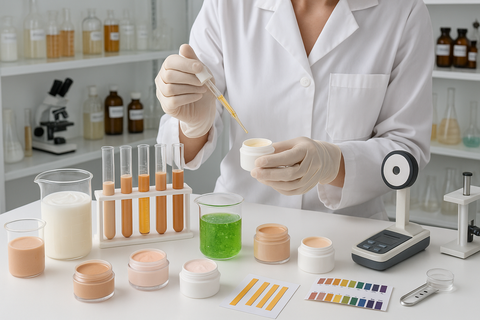Cosmetic formulation testing checks if cosmetics products are safe, stable, and effective. The process includes stability testing. Testing services include product testing. They also perform microbiological testing. They perform compatibility testing. Experts check a cosmetic formulation to see if the ingredients work well together. They also check pH levels and cosmetic regulations. Testing covers raw materials, active & functional ingredients, and interaction forces. Laboratory testing services and predictive stability tests help spot problems early in product development. This ensures compliance with regulatory standards and ISO protocols.
Key testing services and methods
Testing services include chemical analysis. They also perform microbiological analysis. They also perform preservative challenge testing like ISO 11930. Challenge testing, microbial challenge studies, and USP <61> and <62> testing confirm microbial safety. Labs also do heavy metal testing, residual solvent testing, pesticide testing, water testing, and water activity testing. Stability tests like cosmetic stability study and predictive stability test track product performance over time. Physical chemistry and emulsion technology assess texture and structure. Compatibility tests check how ingredients interact with packaging.
Regulatory compliance and standards
Regulatory compliance means meeting rules like Regulation 1223/2009 and Regulation No. 655/2013. Annex II/III substances restrictions and color additives approval from the CosIng database also apply. Other rules include 21 CFR 111 and USP <60>, USP <62>, and USP <61> protocols. Cosmetic laboratory testing follows ISO 16218 and other ISO protocols. Contract laboratory teams check for restricted substances and allergens. They also perform sensitization testing. They also conduct ocular testing and toxicity testing to protect consumers.
Types of stability testing
Stability testing checks chemical and physical stability over time. The tests include cosmetic stability studies and predictive stability tests. They focus on pH levels. They focus on emulsion stability. They focus on ingredient compatibility. Testing also looks at residual metals, microbial challenge studies, and preservative challenge testing. Batch tests monitor appearance, odor, and performance during product development. Compatibility testing studies how active and functional ingredients work with packaging. Formulation parameters and interaction forces show resilience under stress.
Specialized laboratory analyses
Laboratories use gas chromatography to analyze chemicals during testing. Residual solvent testing and heavy metal testing find contaminants. Microbiological testing and microbial challenge studies prove the product is safe. Cosmetic laboratory testing checks for restricted substances. It also reviews color additives and allergens. Cosmetic ingredient suppliers provide raw material data. Independent laboratories test the data to confirm it is accurate. Other services include water activity testing, physical chemistry studies, and compatibility tests. These steps ensure product efficacy.
Safety and efficacy evaluations
Skin patch testing, allergen testing, and ocular testing confirm product safety. Preservative challenge testing and microbial challenge studies check for safe use over time. Predictive stability tests show how the cosmetic formulation performs during storage. Formulation technology depends on how well ingredients work together. It also depends on interaction forces. Emulsion technology helps keep chemicals and physical properties stable. Formulation parameters help keep the product stable. Safety follows ISO 11930, Regulation 1223/2009, and Regulation No. 655/2013. Toxicity testing and restricted substance checks protect health.
Essential elements in cosmetic testing
A complete cosmetic formulation testing process often includes:
- Stability test and cosmetic stability study to check performance
- Microbiological testing and USP <61> and <62> testing for safety
- Heavy metal testing, pesticide testing, and residual solvent testing for contaminants
- Compatibility testing with packaging and active & functional ingredients
- Regulatory compliance checks with ISO protocols, 21 CFR 111, and Annex II/III substances lists
Please contact us to get started with your cosmetic laboratory testing needs.
